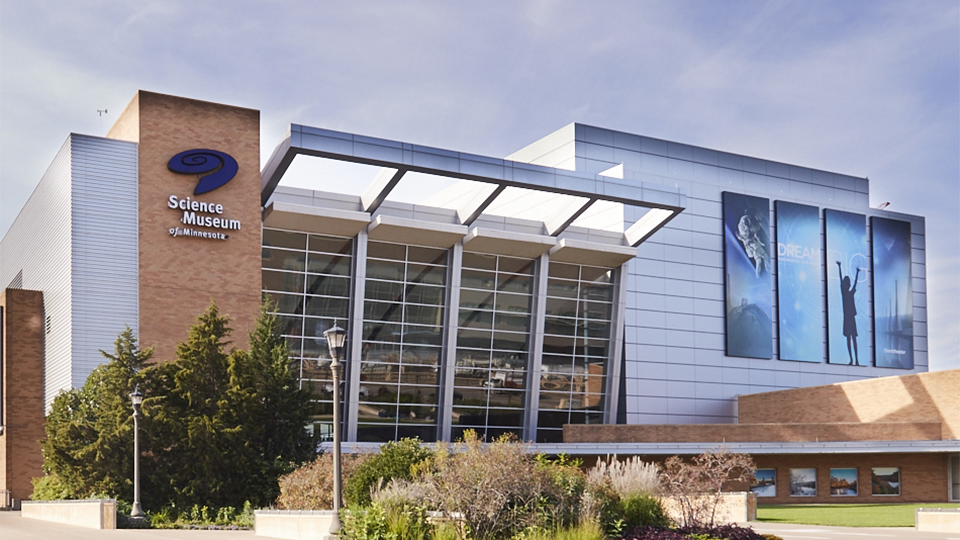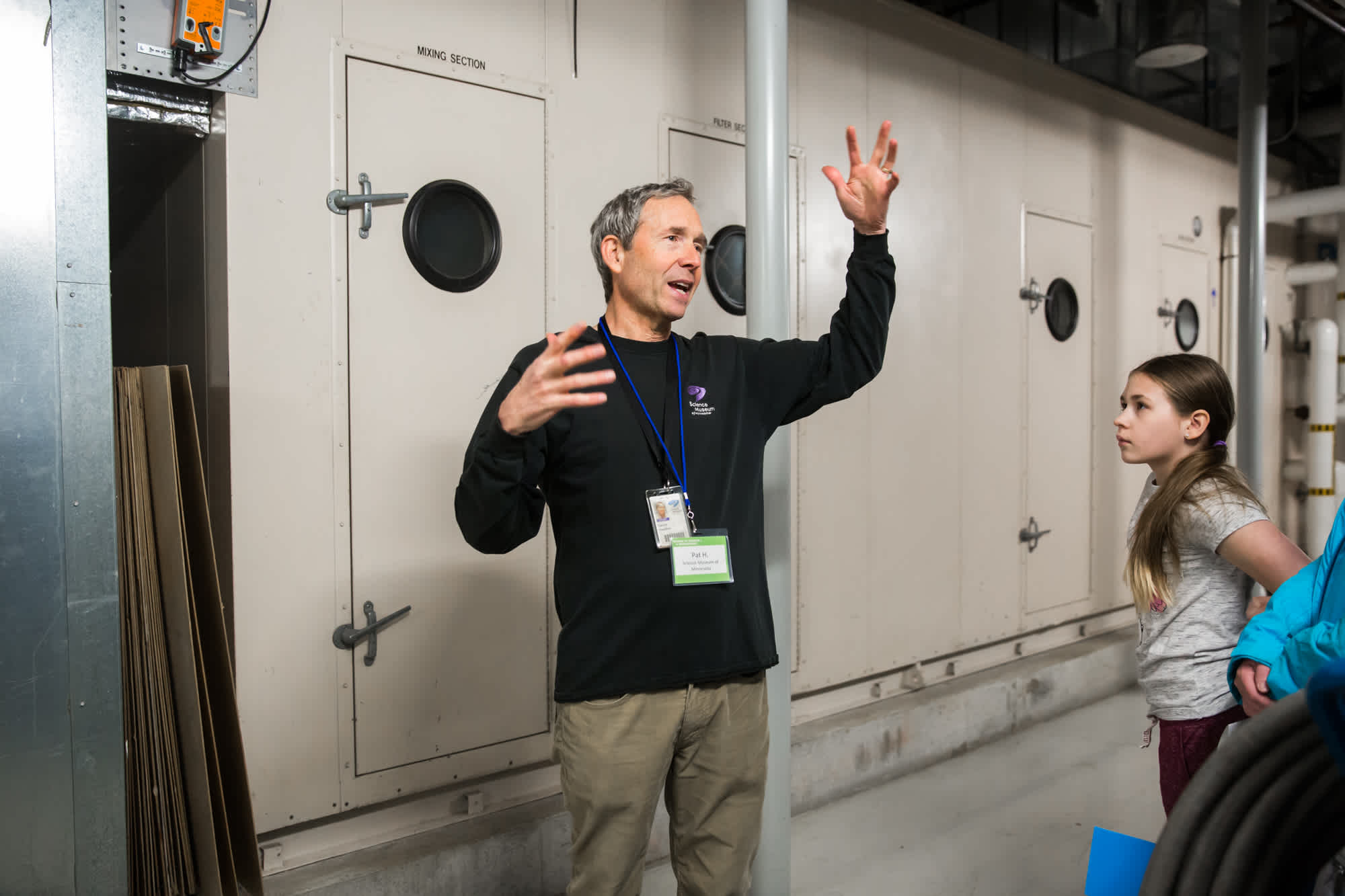
Inside the Science Museum’s green goals
Sustainability can look like improving energy efficiency, planting more trees, reusing wastewater, driving electric vehicles, and everything in-between.
But what does sustainability mean to us here at the Science Museum of Minnesota?
We’re talking with Patrick Hamilton, our Director of Global Change Initiatives, to find out. With over two decades of experience here at the museum, Patrick knows everything there is to know about our building—how it runs, what kind of energy it uses, and the long history of incremental improvements we’ve completed to make it a more sustainable place. Here, we’ll look at a few of our favorite projects and what’s coming next for sustainability at the museum.
Let’s backtrack: Science Museum sustainability history
The Science Museum has 370,000 square feet of space, which includes our exhibit halls, Omnitheater, offices, classrooms, restaurants, and mechanical rooms. That means we’re a pretty big building, which can make it difficult to use electricity and other energy efficiently.
As Hamilton tells it, “large buildings, such as the Science Museum, use large amounts of electricity. Electricity inevitably degrades into heat, and so a lot of heat is generated in spaces that house lots of electronics or electric motors. Large buildings need to manage this heat buildup, otherwise, interior spaces will overheat.” Standard building practice, as was the case at the museum, is to expel this heat energy and treat it as a waste, while at the same time purchasing energy to do work that could be done with the heat energy being thrown away.
Acting on a study conducted by a mechanical engineer in 2010, the museum installed two machines called heat recovery chillers that enable it to extract heat from where it is in excess and move it to where we do need it in 2013.
As a result, the museum has reduced its purchases of hot water by 65% for a savings of $300,000 a year and a 30% reduction in the museum’s contributions to the carbon dioxide pollution that is driving climate change.
In addition to the advanced heat recovery project, the Science Museum has been working to decrease our water use - with great success. Hamilton explains, “The museum’s use of water has dropped both during summer and winter. This across-the-board reduction in water use says to me that the museum has not only reduced its use of water for irrigation, but also improved the efficiency of water use within the museum as well.”
Of course, our bread and butter here at the museum is education, and we’ve had no shortage of sustainability-focused experiences. In 1993, Hamilton helped create an exhibit called Green Street, which showcased innovations and future ideas for a greener world. We’ve kept this tradition going, continuing to feature exhibits and movies that explore Earth’s changing climate and humanity’s impact on it.
We have made sustainability a core part of who we are: from our exhibits and building operations to the items at the Explore Store.
It all comes back to our vision: We imagine a world where everyone has the power to use science to make lives better.
What we're doing now
When you visit the museum, you receive a paper wristband (which is recyclable). While you’re here, you might also buy a coffee from Java Lab or pick up a few of our handy info cards. That is to say, you’ll be creating waste while you’re here. Project No Waste, launched in 2012, is the Science Museum’s comprehensive waste reduction program designed to demonstrate that it is possible to have a community where almost nothing is wasted. We’ve been working on it since 2012, and our facility team is excited to refresh our signage to make it even more clear what goes where, which will help the museum send even less trash to landfills.
Our store staff are passionate about reducing waste and selling more sustainable products, too. The Explore Store is carrying more and more sustainable products these days; like at-home plant growing kits, beeswax food wraps, and soap savers. It matters to us that our products get used for a long time and don’t end up in landfills, which is why we’re continuing to improve our product quality and materials for our famous dinosaur apparel and other science merch.

Let’s shift our focus to what happens on and outside of the Science Museum’s building.
The Twin Cities has many impervious roadways, parking lots, and rooftops, which produce a lot of stormwater runoff from rainfalls and melting snow. This water can pick up a lot of pollutants as it flows across these surfaces before disappearing down storm drains, many of which spill this untreated water directly into nearby environments.
Overlooking the Mississippi River, the museum can be an important example of how to manage stormwater differently, which is why the museum, together with the Capitol Region Watershed District, has contracted with Barr Engineering to conduct a comprehensive stormwater feasibility study of the museum’s building and grounds. Barr will provide us with recommendations to keep improving our stormwater plans.
All of these changes are necessary for creating the world we all want to live in.
Why we're focused on sustainability
It’s simple: “Buildings are responsible for 40% of all energy use in the U.S.,” says Patrick.
“We will not get a handle on climate change without getting a handle on building energy use.” Not to mention, “Every dollar that we save on energy is a dollar we can invest in our science, education, and equity mission,” explains Patrick.
We want to be good stewards and have a positive impact on local communities and the environment—not a negative one. As our climate change statement says: the world is warming, and we have the power to address the challenges that come with it.

What’s next for sustainability at the Science Museum?
First off: extending our sustainability efforts to new and creative endeavors, such as working with the Mississippi Park Connection to create a large community gravel bed in the museum’s outdoor space. The gravel bed will support the 1,200 bare-root trees that the Mississippi Park Connection plans to plant in Crosby Farm Regional Park. These trees will be studied in their ambitious and important research project that focuses on how to prepare our floodplain forests for the impacts of emerald ash borer and climate change. Besides this unique project, we're continuing to improve Project No Waste, add more sustainable products to our store, and find new ways to collaborate with Minnesota's communities to address climate change.
The future is exciting, and we’re sure we can make a difference by finding new ways to be even more sustainable.
We want to bring you along with us on our sustainability journey—because becoming more sustainable is something everyone can do. Learn how you can take action on climate change individually and with your community.